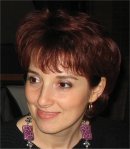|
Plenary
Lecture
Special and Unusual Aspects Regarding Real Scale Impact
Testing Methods for Large Beams

Dr. Carmen
Debeleac
Research Center for Mechanics of Machines and
Technological Equipments
University "Dunarea de Jos" of Galati
Calea Calarasilor 29, 810017, Braila
Romania
E-mail: cbordea@ugal.ro
Abstract: The study deal with some particular
aspects connected to the impact testing methods on real
scale intended for instrumental dynamic analysis of
large beams. Large beams for viaducts, bridges and other
special construction applications necessitate a strictly
analysis of transient states when are subjected both to
regular and to fortuitous dynamic charges. Experimental
tests of these elements are developed both in special
setup places – for a singular element, and "in situ" –
for the serviceable montage. The most usual way to give
it a try of these beams with impulsive loads for real
scale experiments is to use a special truck that passed
over the transversal obstacles with known
characteristics and installed directly upon the rolling
way. In this case the instrumental data have to be
complete by theoretical study that validate and give it
a final confirmation of the qualitative and quantitative
results.
The impulsive charge result as a function of the
singular obstacle shape, dimensions and material
characteristics, and of the number, characteristics and
geometrical configuration and distribution of tires.
This real scale impact test configuration has the main
advantage of a great similarity with the transient
charges that will happen in the future exploitation, and
the experimental results produce a most realistic
characteristic of beams. But, it required a very fine
tuning between the obstacles setup montage with the
truck movement parameters and the tires characteristics,
so that the impact shock has both the necessary energy,
and the suiting spectral distribution.
The author develops an analytic method useful in virtual
simulation of these complex phenomenon and try to
dignify the next major aspects: denote leading
parameters of the process, order in a systematic manner
the whole parameters that have influences, more or less,
in the tire – obstacle – road interactions, put into the
evidence the transient behavior of the large beams
subjected to an intensive and various impulsive charges
with direct relevance in power spectral distribution,
and try to establish the right number of traducers and
their spatial distribution (based on the optimum ratio
between the instrumental requirements and the results
accuracy). Also, it was made a computational dynamics
study based on the classical wave equation with the
final scope of marking out the longitudinal and
transversal propagation phenomenon and their
interferences.
A few partial concluding remarks are: the special
aspects regarding this study results from the great
number of parameters and the complexity of their
relationships, the unusual aspects was dignified by the
comparison between the experimental data and the
computational models, the complexity and the
difficulties of tuning do not recommend this method for
ordinary tests, but the realistic manner of action and
the final results accuracy propose it for each case.
Brief Biography of the Speaker:
Carmen Debeleac (born in 1972) received the PhD degree
in Mechanical Engineering from University "Dunarea de
Jos" of Galati, Romania, in 2006. She obtained a Master
degree in Mechanics - Dynamics of Construction
Equipments, in 2002, at the same University, and a
Senior Manager degree for Scientific Research Projects
at "Politehnica" University - AMCSIT Center, Bucharest,
Romania, in 2006. Since 1997 she is a senior research
scientist at the Research Center for Mechanics of
Machines and Technological Equipments, at Engineering
Faculty in Braila, University "Dunarea de Jos" of Galati,
Romania. She is author of numerous research articles in
referee journals and international conferences, covering
theory of mechanics, dynamics of construction
equipments, vibrations, modelling and simulation of
dynamic phenomenon, technologies for construction
equipments, and is co-author of the book (with G. Axinti,
N. Dragan) Analytic Mechanics with Applications. She has
led and was involved in various research projects and
has a plenary lecture at WSEAS Intl. Conf. Recent
Advances in Automation & Information 2009. She is a
member of International Association of Engineers,
Romanian Society for Theoretical and Applied Mechanics,
Romanian Society of Acoustics, Romanian Association for
Construction Technologies, Equipments and Mechanization,
and she is managing editor, associate editor and
reviewer for national and international journals and
conferences.
|
